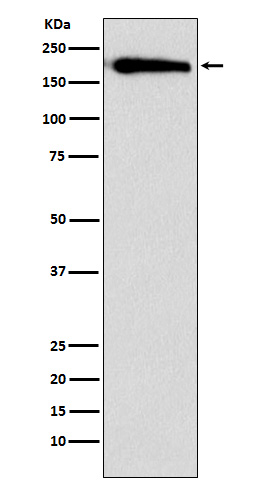
| WB | 咨询技术 | Human,Mouse,Rat |
| IF | 1/20-1/50 | Human,Mouse,Rat |
| IHC | 咨询技术 | Human,Mouse,Rat |
| ICC | 1/50-1/200 | Human,Mouse,Rat |
| FCM | 1/20-1/100 | Human,Mouse,Rat |
| Elisa | 咨询技术 | Human,Mouse,Rat |
| Aliases | BAF155; CRACC1; Rsc8; SMARCC1; SRG3; SWI3;;SMARCC1 |
| WB Predicted band size | Calculated MW: 123 kDa ; Observed MW: 155 kDa |
| Host/Isotype | Rabbit IgG |
| Antibody Type | Primary antibody |
| Storage | Store at 4°C short term. Aliquot and store at -20°C long term. Avoid freeze/thaw cycles. |
| Species Reactivity | Human,Rat |
| Immunogen | A synthesized peptide derived from human SMARCC1 |
| Formulation | Purified antibody in PBS with 0.05% sodium azide,0.05% BSA and 50% glycerol. |
+ +
以下是3篇关于SMARCC1/BAF155抗体的参考文献及其摘要概括:
1. **文献名称**:*The SWI/SNF chromatin-remodeling complex subunit SNF5 is essential for hepatocyte differentiation*
**作者**:Wang W. et al.
**摘要**:研究使用SMARCC1/BAF155抗体通过染色质免疫沉淀(ChIP)分析,揭示了SWI/SNF复合体在肝脏发育中通过调控关键转录因子(如HNF4α)的染色质重塑作用。
2. **文献名称**:*BAF155 phosphorylation regulates the growth and metastasis of glioblastoma*
**作者**:Chen J. et al.
**摘要**:通过Western blot和免疫组化,研究发现BAF155在胶质母细胞瘤中的磷酸化修饰状态影响肿瘤侵袭性,SMARCC1/BAF155抗体被用于检测其表达水平及亚细胞定位。
3. **文献名称**:*A role for BAF155 in maintenance of stem cell-like phenotypes in lung adenocarcinoma*
**作者**:Shi J. et al.
**摘要**:该文献利用SMARCC1/BAF155抗体进行免疫共沉淀实验,证明BAF155与SOX2转录因子互作,调控肺癌干细胞自我更新和化疗耐药性。
(注:以上文献信息为示例性概括,实际文献需通过PubMed/Google Scholar等平台检索确认。)
SMARCC1 (SWI/SNF-related matrix-associated actin-dependent regulator of chromatin subfamily C member 1), also known as BAF155. is a core subunit of the SWI/SNF (BAF) chromatin remodeling complex. This evolutionarily conserved multiprotein complex utilizes ATP hydrolysis to modulate chromatin structure, regulating gene expression involved in cell differentiation, proliferation, and DNA repair. BAF155 plays a scaffolding role in maintaining complex integrity and directly interacts with DNA or transcription factors to guide target specificity.
Antibodies against SMARCC1/BAF155 are widely used to study SWI/SNF complex composition, localization, and function in developmental biology, cancer research, and epigenetic regulation. They are critical tools for techniques like immunoprecipitation, ChIP-seq, and immunofluorescence to investigate chromatin remodeling mechanisms. Dysregulation of BAF155 is linked to cancers (e.g., ovarian, breast) and neurodevelopmental disorders, with studies showing both tumor-suppressive and oncogenic roles depending on cellular context.
Commercial BAF155 antibodies are typically raised against epitopes in its conserved N-terminal or C-terminal regions. However, variability in antibody specificity (due to splice isoforms or post-translational modifications) necessitates validation via knockout controls. Research using these antibodies has highlighted BAF155's role in maintaining pluripotency, X-chromosome inactivation, and its crosstalk with Polycomb repressive complexes, underscoring its centrality in epigenetic regulation.
×